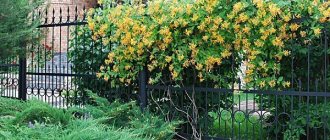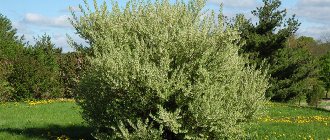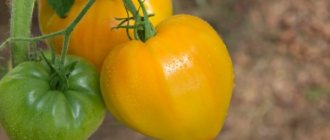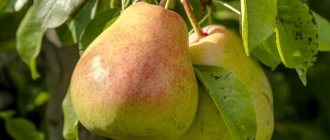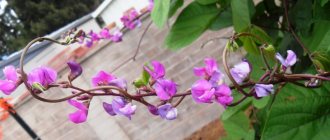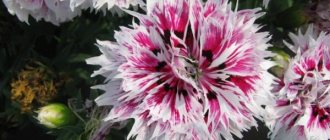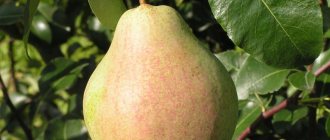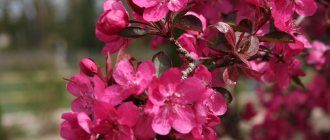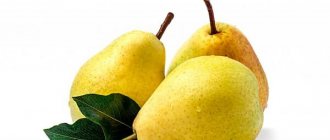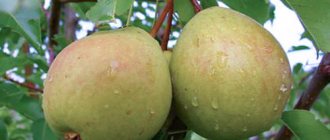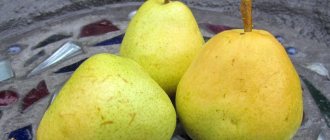Basic information
The homeland of the pear, which has such an intriguing name, is China. However, in the vast expanses of Russia, the ornamental pear has not taken root particularly well due to the peculiarities of its care.
Important! A medium-sized tree with a cone-shaped crown changes its beautiful green foliage to bright red in the fall.
The decorative climbing pear loves sunny areas. It is not winter-hardy, so it cannot be grown in regions with harsh climates. The crop is represented by perennials, but there are also annual varieties.
Ornamental Chinese pears have many varieties, differing in the color of the green mass, the size of the fruit, and their appearance. The most famous varieties are Willow, Beech Hill, Bradford.
Decorative pear
Using decorative pumpkin
Despite the fact that pumpkins are primarily used to decorate the garden, they can be eaten, candied fruits, and jam. For this you should use only young fruits. In old berries, the pulp becomes bitter and becomes tough.
But it’s better to use these unusual beautiful fruits for decoration. You can use them to make an unusual lantern, a vase, a box, or a whole composition. This is a real find for parents of babies.
So, if you decide to grow a decorative pumpkin, you should consider some simple recommendations. Then a real decoration will appear on your site. Decorative pumpkins grow quickly. You can enjoy the lush greenery all summer long, and in the fall you can reap a harvest of amazing fruits. Why not make some cute crafts from this wonderful vegetable in winter?!
Description of culture
Pear Fairytale
This variety is also called nut or flowering. It represents the Rosaceae family. Trees are perfectly adapted to urban conditions. On the ornamental pear in the spring, soft white, very large flowers bloom, fragrant with a pleasant and strong aroma. A flowering tree resembles a bouquet.
Unlike the flowers, the fruits are very modest, small, dark brown in color. They have no nutritional value, because they are not stored, cannot be preserved, and have a bitter taste. After the leaves fall, pears hang on the branches for a long time, serving as a kind of decoration.
The trees have an amazing and attractive appearance due to the beautiful carved leaves. The graceful crown is a real decoration of parks, squares, and gazebo arches.
Harvest and storage
The fruits of ornamental pears are not suitable for consumption, but if some variety interests you with its taste characteristics, then you need to pick the pears according to the same rules as the fruits of dessert varieties: after waiting for full technical maturity, they are carefully removed from the tree and placed in wooden boxes.
In the cool conditions of a basement or refrigerator, they can be stored longer, but at room temperature, pears will not last more than 1-2 weeks, although this is usually not required.
Ornamental varieties of fruit plants are a great way to give your site an exotic appeal in affordable ways, so if possible, do not hesitate to plant climbing or simply flowering varieties of pears in your garden.
Varieties of decorative pears
To decorate recreation areas, different varieties of ornamental pear are used.
Callera Chanticleer
Callera Chanticleer
Pear Rainbow
This is the most famous variety that came from China. In their homeland, trees grow in forests, groves, and rise above the banks of rivers.
The pear is characterized by rapid growth, adding 40 cm annually. Its crown has a regular conical shape, over the years it turns into a wide pyramidal one. The dark green shiny leaves bloom early and change color from November.
Flowers begin to bloom in April simultaneously with the leaves, but sometimes flowering is somewhat ahead of their appearance. The fruits that appear are quite edible, but the taste is very low.
Important! A young pear may suffer from severe frost, but as it matures it becomes frost-resistant.
Chanticleer is not afraid of polluted air, which is why it is actively planted in cities.
Callery Bradford
This variety comes from the USA. It is distinguished by its large size, with a trunk diameter reaching 9 m and a height of 12 m. The symmetrical pyramidal crown is very dense and compact. Large, oval, dark green leaves with a glossy surface turn orange to purple in autumn.
Bradford blooms abundantly from the end of March. The flowers are very beautiful and quite large. The resulting fruits are inedible. The decorative pear has a short growth period - only up to 25 years.
Callery Bradford
Willow
A very unpretentious plant found in the wild in the Caucasus and Asia. It is also cultivated artificially. The tree easily tolerates dense, moist soils and grows in salty ones. The only whim of the Willow Pear is the absence of gusty cold winds and the love of light.
The willow pear grows very slowly. Its crown resembles a spreading tent. In May, the tree blooms with large flowers collected in corymbs.
The tree has high frost resistance and easily tolerates forced drought. Due to the pear’s ability to withstand gas and dust, it is widely used to green up cities.
Beach Hill
In the wild, this pear can be found in Asia Minor and Europe. A distinctive feature of the variety is its powerful branch structure and narrow pyramidal crown.
Beach Hill
Large bright green leaves tightly fit the branches. In autumn they turn yellow and orange.
The tree blooms in May. The flowers are large and fragrant. The pears themselves taste sour with an unpleasant tartness. Urban conditions do not bother the pear, and it takes root quite well in parks and squares.
The tree is not frost-resistant, and is mostly grown in the southern regions. The plant lives up to 150 years.
Benefits of decorative pumpkins
This unusual plant has a number of important advantages:
- It's beautiful. Many people will like the powerful stems with large succulent leaves, decorated with bright flowers and unusual bright fruits of different complexions. Such non-standard decor will immediately attract the attention of others.
- Growing quickly. Each climbing lash quickly grows to 4-6 meters. It is recommended to let them go along supports, because the plant will cope perfectly with landscaping, decorating gazebos and other objects.
- There is a bush form. It is recommended to plant it in flowerpots and display it on terraces.
- It will attract the attention of not only adults, but also children. This is a godsend for a children's garden.
- The plant is easy to care for. The main thing is to ensure regular watering.
- Cute beautiful pumpkins are perfect for crafts and design. The main thing is to wait until they ripen, clean the seeds, and dry them. From such specimens you can create many useful and beautiful curiosities - candlesticks, boxes, compositions. It is difficult to find two identical berries. Each has an original coloring and “figure”.
Cultivation of ornamental pear
You can grow a tree from cuttings, from seeds, or by grafting. Willow pear can be propagated by root shoots. For novice gardeners, growing an unusual tree using a small seed may seem problematic, but it is quite possible.
Seed selection
To grow an ornamental plant from a seed, you need to be able to choose and prepare the seed correctly. Growing a seedling in an apartment is not at all difficult if you take into account some nuances.
The seeds are removed from the ripe fruit and poured with hot water. Having washed the required amount of seed in this way, it is dried well and, packed in a sealed bag, put away in the refrigerator until spring.
Soil and site selection
The next stage of preparation is the selection of soil and preparation of a permanent place on the site. Any plant actively develops in fertile soil. Swampy places with expected stagnation of moisture are not suitable for ornamental pear seedlings. Drafts are contraindicated for trees; this should be taken into account when choosing a location.
Cultivation of ornamental pear
This species should be planted in sunny places; light partial shade is acceptable. The optimal soil is sandy loam, at least loamy.
Seed preparation
Take the seeds out of the refrigerator and lay them out to warm to room temperature. Next, the grains are soaked in warm water for 3 days, changing it daily. In the last 24 hours, any of the available growth stimulants are added to the water. After this, the seeds are stratified for better germination.
The mixture is prepared from perlite, river sand, coconut substrate and high-moor silt. It is moistened and pear grains are laid on top. Cover the container with the seed with film and put it in the refrigerator for a period of 80-90 days. In the future, you need to check the humidity level in the container and make sure that the seeds do not rot.
When the seeds germinate, they should be planted in nutritious soil. When 4 pairs of leaves appear, the seedlings dive.
Planting a tree
Planting an ornamental pear is not much different from planting other trees. An annual seedling is planted in the spring so that it is well rooted by winter.
Planting a tree
The planting pit is filled with a fertile mixture and a mineral additive. The root is examined and damage is removed. The seedling is carefully buried, carefully handling the root system. For reliability, install a peg and fix the tree. The tree trunk circle is watered and mulched.
Growing rules
The willow pear is propagated by cuttings, layering or root shoots. It is often used as a scion for wild crop varieties. The place for the tree should be sunny, without shade, on well-drained soils. Planting of seedlings is carried out in spring or autumn in a hole of 80 cm/1 m, using a fertile substrate. A prerequisite for the landing recess is that the bottom is covered with a drainage pad. The material must be taken at least one year old.
Important! When planting a pear, the root collar is left above the soil level.
Agricultural technology for the loosestrife pear is standard; care is oriented towards the biological characteristics of the crop:
- Watering is moderate; for an adult plant, drying out of the root ball is quite acceptable. The plant is drought-resistant, the root system, completely deepened, provides the tree with the necessary moisture. In the dry season, water the pear 3 times: after flowering, in July and September with a large volume of water. Seedlings up to 2 years old are watered 2 times a month.
- When planting, a fertile mixture is placed at the bottom of the hole; the willow pear has enough nutrients for 3 years. Then the tree is fed every year: at the beginning of the growing season - with compost or superphosphate.
- The crown is formed in the spring, according to the design plan; when creating a trunk, pruning of the lower branches is carried out in the 3rd year of growth, the crown is thinned out in subsequent years. If the crown formation occurs naturally, sanitary pruning is carried out in the spring, frozen and dry branches are removed.
When growing willow pear in a temperate climate, prepare the plant for winter. Abundant watering is carried out, the trunk is wrapped in burlap and the trunk circle is mulched.
Further care
They are cared for in the standard way: pruning, watering, fertilizing, loosening.
Ornamental pears love sprinkling, especially the Willow pear. Fertilizer is applied every 3 years, but if the soil is too poor, then fertilizing is done annually.
The formation of the crown of trees is natural, but if desired, you can give it a shape that matches the design. Sanitary pruning is carried out at the beginning and end of the season.
Pests and diseases
The ornamental pear is an almost wild plant, therefore it has good immunity to diseases. However, systematic treatment with chemicals is still necessary. Of all the diseases, the tree can sometimes be threatened by black spot, leaf curl and fire blight.
Bacterial burn
Because of this disease, the beautiful leaves of the ornamental pear take on the appearance as if after a fire. The disease is caused by microorganisms of the Enterobacteriaceae family.
Bacterial burn
A bacterial burn is treated with copper-containing preparations, and the removal of all affected parts of the tree is also required.
Brown spot
The Entomosporium fungus is active in spring and fall. The first sign of its presence on the plant is the presence of red spots on young leaves. Over time, they turn gray, then turn black and spread throughout the green mass.
They get rid of the fungus with topaz and phytosporin-M.
Pests and diseases
If the growing conditions are met, the willow pear rarely gets sick. But, like any representative of the species, it can be affected by the following infection:
- Leaf curl. The disease affects young leaves, they stop growing, curl, turn brown and fall off. To prevent the development of the disease, the pear is treated with products containing copper or iron before the buds begin to grow.
- Brown spot. A fungal infection affects the leaves, manifests itself as dark spots on the surface, then the areas increase and cover the leaf plate completely. To eliminate the fungus, use “Topaz” or “Fundazol”.
- Bacterial burn. The infection progresses with high soil and air humidity. The tree is completely affected, the flowers change color to dark yellow, the branches and fruits turn black, the leaves dry out. Bacterial contamination is eliminated with copper sulfate or Bordeaux mixture, problem areas are cut off and removed from the area.
Among the pests that pose a threat to the willow pear are:
- gall mites, get rid of them with “Trichlormetafos”, “Karbofos”;
- pear worm, eliminate the pest with “Decis” or “Agrovertin”;
- pear codling moth, destroy caterpillars with “Fufanon”.
As a preventive measure, the crown is treated with copper sulfate in the spring before the sap flows. Whiten the trunk with lime or water-based paint.
Decorative pumpkin in the shape of a pear: description and photo - can it be eaten?
Some of us love pumpkin; many know special recipes to make pumpkin dishes tasty and healthy. But few of us know that there are special varieties of pumpkin that are grown not for food, but to make decorative decorations from it. These types include decorative pumpkin.
In European culture and the United States, these varieties have long been fashionable and many Western gardeners grow these varieties to decorate the facades of their homes, wedding ceremonies, and much more. But can these varieties be eaten, and what kind of pumpkin is this - more about that.
Is decorative pumpkin good for food?
The decorative pumpkin was originally grown as a form from which a wide variety of decorations could be made. Therefore, there can be no talk about the nutritional qualities of this plant. Because a ripe pumpkin has a hard skin and no nutrients.
But some varieties, which have not yet ripened and still have a soft shell and pulp, can be used in cooking. But for this, a regular pumpkin is best suited. Is it possible to eat it? Definitely yes. And the decorative option should be used in design ideas and handicrafts. Typically, gardeners wait for the fruit to ripen and fade, the skin to become thick and rough, and the stalk to dry out.
How to grow and care for decorative pumpkin
In order to grow such beauty in your garden plot, you don’t need much effort. A decorative climbing pumpkin does not require any special skills or abilities. To do this you only need to know a few simple techniques.
Decorative pumpkins grow well in well-lit areas. But they still need to be slightly darkened. The soil should be loose, fertile and saturated with neutral or weak acidity.
Before you start planting the seeds, it is best to germinate them in a dark and warm place. It should be noted that planting a decorative pumpkin can be done in two ways:
- With the help of seedlings. In this case, it is best to start sowing from April 25 to May 5. Seeds are planted one at a time in deep containers with loose, nutrient-rich soil. And then they put it in a greenhouse.
- Direct sowing in open ground. This method is done in early June, after the frosts have finally ended. And for this they need to be replanted along with the soil. But this must be done carefully so as not to damage the root. The distance between shoots should be at least 20 - 30 cm.
You should know that the plant is vulnerable to low temperatures and cannot tolerate a drop of even one degree. Therefore, you need to prepare the bed in advance so that the night cold does not destroy the crop.
To care for a decorative pumpkin, you just need to loosen the soil from time to time and water the plant regularly. And like any other pumpkin, spring fertilizer is best for it (organic fertilizer is best).
When the first shoots emerge, it will be necessary to do the first fertilizing. And when the ovary appears, fertilizers are added again.
Usually the plant does not require shoots to be artificially formed. But sometimes it is necessary to pinch when the shoot reaches a meter in length. This is done in order to speed up the growth process of side shoots.
Since the decorative pumpkin is predominantly climbing, it therefore needs to be provided with stable support. This support must withstand small but heavy fruits, as well as curly, dense shoots. And when the first autumn cold comes, it will be necessary to cover all the shoots with special material so that the plant does not die and produces a harvest for the next year.
Varieties of pumpkins with large fruits
Many gardeners strive to grow a truly gigantic vegetable. There are many record holders among representatives of this culture. To achieve your cherished goal, it is not enough to properly care for the plant. A prerequisite for success is a correctly selected variety that produces large fruits.
Large-fruited types of pumpkin:
- Flashlight;
- Titanium;
- Centner;
- Atlantic giant;
- Fatty;
- Parisian gold;
- Russian porridge.
Pumpkin lantern
The average weight of one fruit of this selection variety is approximately 6 kg. With proper care and feeding, you can get larger specimens. The variety has a long shelf life. Juicy, crispy flesh is hidden under a fairly thin skin.
Russian porridge
Table variety, distinguished by large fruits. The average weight of a pumpkin reaches 7 kg. The fruits are round, bright orange with a slight pink tint.
Characteristic:
- mid-season;
- Up to 4 fruits ripen on one plant;
- the pulp has a pleasant aroma and balanced taste;
- used in cooking for preparing side dishes, soups, and cereals.
What is a decorative pumpkin
A climbing annual plant is grown to decorate their garden plots, as well as the facades of houses. In addition, crafts made from pear-shaped pumpkins will become a real decoration at children's exhibitions and festivals. Outwardly, she is very similar to her garden relative. Growing it is not difficult.
The shoots grow very quickly and reach 2 m in length (although there are observations when the length reached 4 - 6 meters). But they are much thinner than those of an ordinary pumpkin. There are also bush varieties that are planted along the terraces to decorate them with their appearance. The leaves of the decorative species are slightly thinner than those of the original. But, depending on the variety, the color and appearance may vary.
And as the shoot develops, white flowers will begin to appear on it, which form the ovary of the future decorative pumpkin.
The fruits of this species usually measure no more than 10–15 cm in diameter. And during the summer season, from 20 to 40 small pumpkins can form on one shoot. But the most important thing is that all the fruits have a wide variety of colors.
Therefore, many designers and stylists use this material to create truly unique masterpieces. And the gardeners themselves amaze guests with their unusual creative developments. Just look at these photos.
